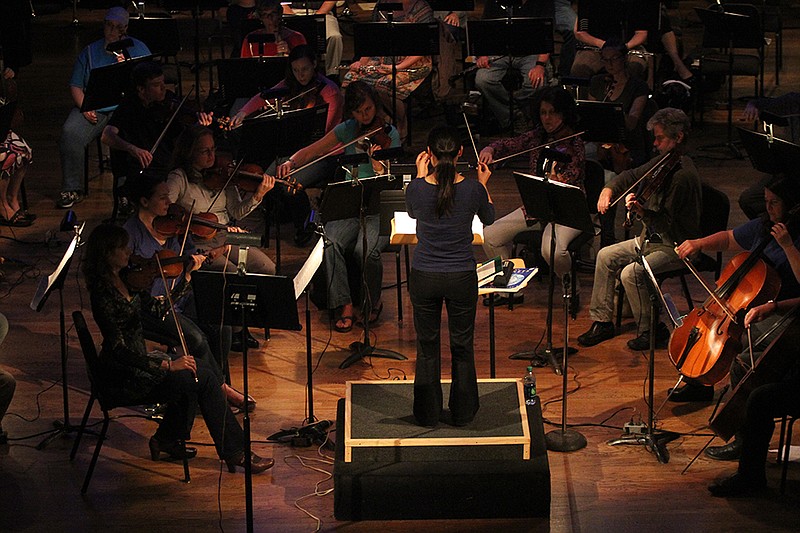The latest buzz about the Chattanooga Symphony is splashed across its website, featuring opera superstar Renee Fleming in concert next season. That announcement alone generated lots of excited talk at Thursday evening's orchestra concert at the Tivoli Theater. And on the heels of this season's Yo-Yo Ma concert, the CSO certainly seems to be aiming high, indeed.
On Thursday evening, the symphony-under the leadership of Music Director Kayoko Dan-presented an unusual offering for its first outing in 2015.
Gypsies-Romani-have always occupied a paradoxical position in European life. As a nomadic group with roots in India, Gypsies' appearance and unsettled way of life made them unwelcome in many lands.
One exception was Hungary, which provided a high degree of tolerance-hence, the conflation of Gypsy and Hungarian, at least, musically.
Both Franz Liszt and Johannes Brahms reinforced the idea that Gypsy music embodied true Hungarian folk music ("verbunkos") with its spirit of improvisation and freedom, seeking to capture it in their compositions, often for piano.
From those piano works, Brahms masterfully arranged "Hungarian Dances Nos. 1, 3, and 10" for orchestra. And it fit the CSO perfectly. From the first rich chords to the subtle dynamic moments, Maestro Dan spurred her forces to dance and spin with fine intonation and tight ensemble. It was a delightful program to open the concert.
The second offering of the evening was provided by Javier Oviedo, a noted soloist and chamber performer on the saxophone. His recordings and performances in venues such as Carnegie Hall have revealed him as one of the leading classical performers on the instrument.
Because the saxophone is a comparatively recent instrument (invented in 1846), it lacks the same rich repertoire of literature available for the violin or piano. That has required serious performers to arrange older compositions (transcriptions) or encourage new works. This performance featured the latter of those.
Commissioned in 2012 for Orviedo, "Samsara: Concerto for Saxophone and Strings" by Helene Rasquier carries a Sanskrit title that refers to the cycle of death and rebirth. It features the typical three movements but was composed for two versions of the saxophone-the smaller, higher soprano instrument and the lower, richer alto member, popular in bands and jazz ensembles.
The combination of solo saxophone with string orchestra seemed an inspired one. For much of the three movements Orviedo spun a haunting filigree of tone over the impressionistic strings. At times, his creamy tone almost approached a plaintive cry while his phrasing and articulation were always spot on.
And the dialogue between the soprano and alto instruments-which he alternated in movement two-made the most of the contrasting timbres.
While both the title "Samsara" and comments by Maestro Kayoko Dan seemed to suggest the work would reflect more struggle and angst, that element seemed to be wholly missing. It was clearly a moving work of impressionistic music, but its emotional range was somewhat limited with little opportunity for fireworks or deeper emotions.
For various reasons, in the world of orchestral music, the saxophone has been considered the Rodney Dangerfield of instruments: it has enjoyed little respect. It's not even a regular instrument in the orchestra. But if the impressive playing of Javier Orviedo is any indication, that just might change.
Sparkling is the overused term to describe Felix Mendelssohn's glorious "Italian" Symphony-but it's entirely apt. This traditional, four-movement work effervesces and charms from beginning to end. It resulted from the composer's travels throughout Italy during his twenty-first year. He finished it upon returning home, and it was premiered with the London Philharmonic Society in 1833. However, the composer wasn't completely satisfied with the work and never allowed it to be played in his native Germany during his lifetime. That was certainly a miscalculation, for "Symphony No. 4 in A Major, Op 90" (Italian) is one of the composer's greatest hits.
For some reason, those rich-sounding strings heard earlier in the Brahms sounded thin and underpowered in the first movement. In addition, both the usually solid intonation and fine ensemble work were noticeably absent at times. The second movement recovered a bit as a melancholy minor melody unfolded over a hauntingly insistent bass line. But the third movement reverted to some if its previous problems, sounding downright under-rehearsed at points.
Then, bang. With the opening bars of the last movement, everything seemed to coalesce. The ensemble tightened up, the string sound noticeably improved, and there was some great inner voicing that showed off thoughtful playing. Actually, it felt like more like a wild ride through the countryside on a very spirited Italian stallion-on a very sunny day.
Some creative programming, indeed, combining fascinating new works and a beloved classic.
